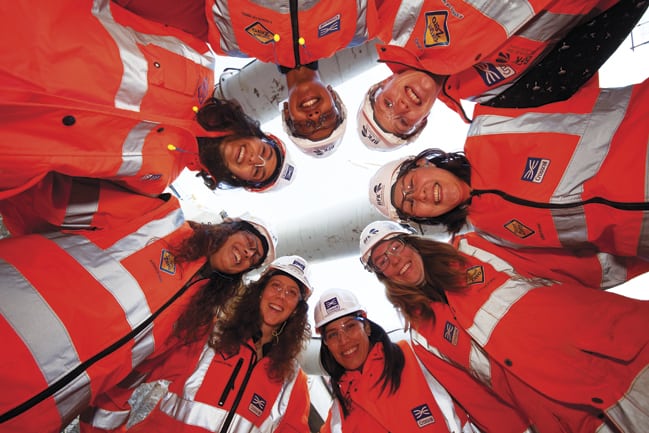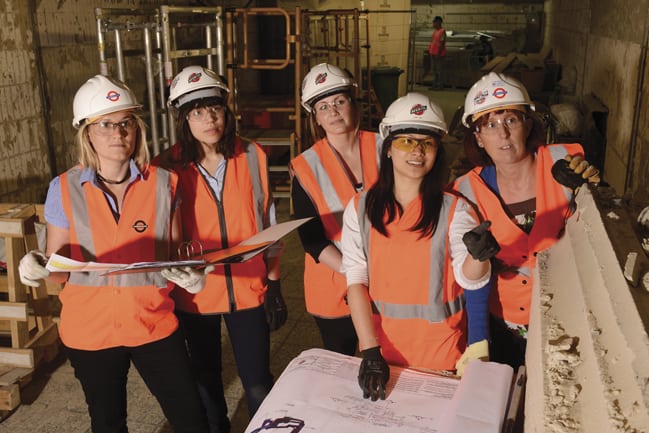It can be easy to get lost in headline figures on the lack of women in engineering. But dig a little deeper, and some surprising results emerge. For instance, in The Engineer’s very own salary survey (see page 42), civil engineering is revealed to be a relatively attractive sector for women.

Despite a very low level of women in engineering overall — around 5.6 per cent of the workforce — the survey of 4,365 engineers revealed that the gender balance is unusually positive, or at least better, in the civil engineering sector. Around 15.3 per cent of the civil engineers responding were women — a figure that is reflected in other industry studies.
The UK has the lowest proportion of female engineers compared with the rest of the European Union at less than 10 per cent.
According to a recent report by EngineeringUK, mechanical engineering has the lowest proportion of female applicants, ranging from 6.4 per cent in 2009 and 2010 to 8.4 per cent in 2012 and 2013. During the same period, the proportion of female applicants to aerospace engineering declined to 7.6 per cent. The proportion of female applicants in general engineering and civil engineering was similar in 2012 and 2013, at around 16.4 per cent and 16.5 per cent respectively.
But what is it about civil engineering that means it bucks the trend so dramatically? Lani Tan, a project field engineer at Bechtel, working on the Vauxhall Underground Station Upgrade project, believes that the direct impact civil engineering has on helping community helps attract women to the field.
It is easy to see how the work of civil engineers improves the lives of so many people…Other disciplines may not be perceived to be directly helping people in this way
Lani Tan, Bechtel
“It is easy to see how the work of civil engineers improves the lives of so many people,” she said. “Water supply and sanitation mean better health; building schools means better education; better transportation links improve quality of life, etc. I think this is appealing to both women and girls. Other disciplines may not be perceived to be directly helping people in this way.”
According to a careers research study led by Atkins, almost four in 10 women who decided to become an engineer had a family connection such as a father or friend who was an engineer. This highlights the importance of having role models, especially for women, as they might give an awareness of what civil engineers actually do and can break down the stigma that civil engineering is only for men. Initiatives in the sector to encourage mentoring may have paid off more so in the civil sector.
While she doesn’t have direct evidence for this, Dawn Bonfield president of the Women’s Engineering Society, claims that women are more aware of what civil engineering entails, compared with, for instance, electrical engineering. “Also, it is linked to creativity and innovation more than other areas of engineering, as there have been a lot of iconic buildings and bridges and other structures over the last few years that have really grabbed public attention,” she explained. “Girls respond well to using their creativity and innovation skills, and I think that this is a reason why it is popular.”

There is also some evidence that civil engineering is taking a different approach. For instance, UCL civil engineering professor Nick Tyler said he believed his course was missing out on creative students by prohibiting applications due to subject choices made at age 15 or 16. His team has seen a huge increase in applications from women after they decided in 2006 that students no longer require physics or maths at A-level for the entry criteria.
Other universities, such as Southampton, have changed course name and focus to combine engineering with architecture, providing a cross-discipline attraction.
But the civil engineering sector still has much more to do to attract women into the industry. The UK has the lowest proportion of female engineers compared with the rest of the European Union at less than 10 per cent.
Meanwhile, the female membership of the Institution of Civil Engineers is still only 10.7 per cent.
With the UK female workforce being at 45.1 per cent, women are still massively underrepresented in civil engineering and there remains a significant salary gap.
Lee Franck, a senior engineer at Arup, claims the results of The Engineer’s salary survey show just how big an issue it is for women. “The fact that a large proportion of women have responded to the salary survey, when compared with the average of women employed in the sector, might be a sign that they feel concerned about the gender wage gap that is still present within our industry and are keen to raise awareness of this by completing the survey,” she said.

Dealing with unconscious bias in the work place is a priority for Tan at Bechtel. Often, she said, it is the many little things that add up over time, such as engineers and project managers being referred to as ‘he’.
“We need to increase the public perception of what engineering is about so that young women see engineering as a credible career option,” added Claire Rose, a senior civil engineer working at Bechtel on the West Coast Route electrification project.
Initiatives for getting more women into the industry should never be targeted and tailored at women only
Lee Franck, Arup
“The sector should target pre-decision making — before GCSEs and A-levels — so that we can attract women to stay on and study science and mathematics so they have the prerequisite courses to make engineering a viable career option at university,” she added.
“I personally think that initiatives for getting more women into the industry should never be targeted and tailored at women only,” said Franck. “That is why I have become involved in a programme called ‘Inspiring the Future’, which gives professionals such as myself the opportunity to visit schools and talk about what engineers really do.
“If we can portray our job as the stimulating, diverse and rewarding job that it is, this should be attractive to all genders, break down any false perceptions of barriers or misconceptions and generally get more talented and motivated people into the industry, which is what we need,” she added.




Poll: Should the UK’s railways be renationalised?
I _do_ remember British Rail - and that it was <i>literally</i> a national joke https://youtu.be/zV2lmSDKvO8